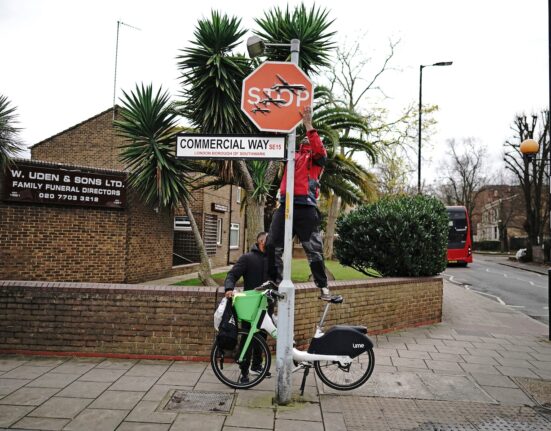During the lockdown days of the pandemic in early 2020, Aaron Rose found himself sifting through old papers in his home in Hollywood. “I can’t let anything go. I’m a hoarder. That’s why there were 200 poems from 1989 sitting in a box,” he said with a laugh.
Mr. Rose, 54, has held many jobs. When people ask him to pick a lane, he’ll say he is a “polymath,” which he knows is a cop-out. Fine, then: “Artist encompasses all of it.”
For 10 years from 1992 to 2002, he ran Alleged Gallery, the influential Lower East Side space where people like Chloë Sevigny and Chan Marshall hung out and a generation of artists like Mike Mills, Shepard Fairey, Tom Sachs, and Mark Gonzales got their start. He’s also a filmmaker known for the 2008 documentary “Beautiful Losers” about the Mission School art scene of the 1990s and “Portraits of Braddock,” which followed Senator John Fetterman when he served as mayor. Sometimes he paints, too.
And now, Mr. Rose is officially a poet, this month publishing “Blackout Poems”: a slim, pocket-size book he wrote from age 19 to his early 20s, scrawling his work on cocktail napkins, inside matchbooks, over shopping bags. Many were written at long-closed, indie spots known to attract those same “beautiful losers” he showcased: Mars Bar, Horseshoe Bar. The cover is a snapshot taken of Mr. Rose with a vicious shiner, the result of a bar fight at Max Fish on Ludlow Street, which happened to be a few doors down from his gallery.
Mr. Rose grew up in Calabasas, Calif., long before the Kardashians and Jenners made it globally recognizable. He played guitar in an acoustic punk band called Cat Furniture, and he dedicated “Blackout Poems” to the group’s late singer, Paco Bliss. When the band broke up in 1989, Mr. Rose moved to New York City. “The second I saw St. Mark’s Place — I mean, it was crazy. I was just like, I’m home,” he said.
He didn’t yet have many friends, so he spent his time drinking in bars, meeting people in Tompkins Square Park and doing drugs. (“I was never really a proper junkie,” he noted.) For his first three years in the city, his life followed a loose but meandering pattern. “I would meet a girl, be in a relationship for a little while, move in with her. Then we’d break up, and then I’d be homeless for a little while, really just bouncing around,” he said. “These works in this book are very much a result of that.”
The poems do include many lovelorn references. “Hearts not broken/ but bruised:/ tried to cash my soul in/ But the window refused,” he writes in “Angels (2 a.m.).” There are numerous allusions to California, drugs, sex, violence.
Mr. Rose struggles to name a favorite. “I love them and it’s really nice to get them out, but I’m also completely and totally embarrassed by every single one of them,” he said.
The $12 book is more like a zine, made with a young generation in mind. “I see a lot of very accomplished poets putting their work out, but I don’t see a lot of published poems that are from a different phase of a writer’s life.”
If he were to publish poetry he wrote now, he thinks it might be technically better, but perhaps less honest.
Mr. Rose’s poetry output slowed down by 1992, when he opened Alleged Gallery on Ludlow Street (now the home of a Van Leeuwen ice cream parlor). The art shows he threw were like parties, and attracted a community at the intersection of punk, hip-hop, skateboarding and high fashion: members of Beastie Boys and Sonic Youth, the director Harmony Korine and Ms. Sevigny, his then-girlfriend. Mr. Rose dated Tatiana von Furstenberg, the daughter of the designer Diane von Furstenberg.
“Barry McGee, I knew him as a graffiti writer Twist — we knew each other through that world before he was even, I think, really considering fine art,” Mr. Rose said. Artists from the gallery were beginning to take off.
By 2001, Alleged had moved to the Meatpacking District and rent was $10,000 per month, Mr. Rose remembered. “Jeffrey Deitch stole my four biggest artists. Which he’s since apologized for — we’re good friends and we’ve worked together a lot, so it’s fine,” he continued. “But people had started moving on to bigger galleries, and I couldn’t sustain the same kind of support. I couldn’t match those kinds of galleries.”
Alleged had plenty of cultural impact but was not making money. A friend in Los Angeles told Mr. Rose about a space available on Chung King Road, a burgeoning area of young galleries near downtown. And rent on an available space was $400.
He arrived back in L.A. on Sept. 9, 2001. “I moved back into my childhood bedroom,” he said.
The Annex, his L.A. gallery and bookstore, suffered from a lack of foot traffic and lasted just a year.
In 2002, he was approached to curate a museum show at the Contemporary Art Center in Cincinnati featuring artists from his world. The result, which opened two years later, called “Beautiful Losers,” included work from Mr. Fairey, Mr. McGee, Mr. Mills, Mr. Gonzales Clare Rojas, Margaret Kilgallen, and Ryan McGinness, and toured the world.
Despite publishing a book of poems from the era, Mr. Rose doesn’t dwell in 1990s nostalgia, even if a lot of his young fans are attracted to that time.
“The Instagram and the TikTok era has been really inspiring,” he said. “Gen Z people are so bold in what they’re willing to just slap on their profile with actually no experience. At first I was annoyed by that. I’m like, I’ve been working 25 years to call myself that. And then I was like, well, that’s kind of great.”







